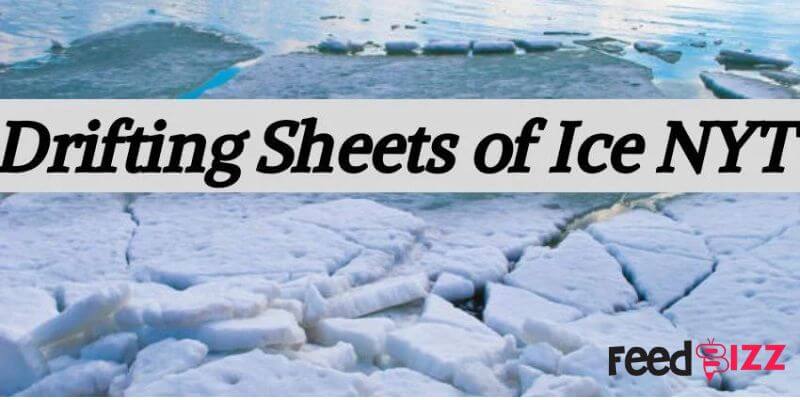They always inspired me and still do, particularly when they are used in articles such as the New York Times. While these mammoth ice structures are simply fascinating to the eyes, one has to understand that they are elemental in our earth’s climate management. When considering what these drifting ice sheets may tell, the answer is, as it turns out, a lot about shifting environmental conditions and difficulties resulting from global warming.
In knowing the drifting sheets of ice nyt is not just an academic pursuit, but knowing all what rising sea levels and weather mean. This knowledge about the said planets helps in understanding the fluctuations in the climate and, accordingly, taking measures to save the environment. Nevertheless, it is interesting to make conclusions about how the state, which seems so detached from our life in the metropolitan, can find itself reflected in a single day.
If you have ever wanted to know more about the polar regions or you have found yourself struggling over a crossword that has something to do with ice that drifts, then you are in the right place. Now, let’s look at what drifting sheets of ice are in more detail and why they are important in further detail to understand why they have become a focus in both science and puzzle solving.
What Are Drifting Sheets of Ice?
Ice floes are large flat areas of ice that have thawed and are floating in the water on their own and originated from ice shelves and glaciers, etc. In form, these sheets may be relatively small, several meters wide, or very large, spanning several kilometres. The formation of these ice sheets starts in polar regions in which the continual collection of the snow and ice forms great and dense solid structure. Such masses can be detached and carried afloat by sea currents and winds as these masses stretch far into the sea.
Vast floating ice masses have a significant impact on climate the climate system of the planet. They work at reflecting the sun’s rays, whereby they assist in controlling the climate of the planet. Also, it acts as a home to different sea creatures, such as seals and polar bears, who use the ice for hunting and sleeping, respectively. Research about these drifting sheets is very crucial in analyzing the terrestrial ecosystem prevalent in polar regions as well as the impact of climate change on our ecosystem.
The Role of Drifting Sheets of Ice in Climate Change
The melting and drifting of ice sheets are directly linked to global climate change. As the Earth’s temperature rises, ice sheets begin to melt at a faster rate, contributing to rising sea levels. This melting is not only a concern for coastal regions but also affects global ocean circulation patterns. Drifting sheets of ice, by moving through the oceans, can influence these patterns, altering weather systems and climate conditions far from their origin.
Also, when floating icebergs of icebergs break and melt, clear water is returned to the oceans. This freshwater upsets the salinity of the ocean; it affects marine life and the overall climate. These ice sheets are closely watched by scientists in order to project these changes in the climate in the future and in order to study the effects of these changes on the ecosystems in the region of the ice sheets as well as the overall weather patterns in the world.
Drifting Sheets of Ice in the New York Times
The New York Times has covered the topic of drifting sheets of ice extensively, often highlighting their role in environmental and climate discussions. Articles from the Times have brought attention to the dramatic changes occurring in polar regions, showcasing how these drifting ice sheets serve as indicators of climate change. The publication has reported on scientific expeditions that study these ice formations and has featured interviews with experts who provide insights into the implications of melting ice.
Far from being just environmental conduct, drifting sheets of ice are also mimicked by the New York Times in its crossword times as well. Not only are these clues fun, but they also keep the common people informed about some critical environmental facts while also trying to create awareness about the depleting ice on the planet.
Drifting Sheets of Ice NYT Crossword Clue Explained
The New York Times crossword puzzle often includes clues related to drifting sheets of ice, making it a fun and educational feature. Clues like “drifting sheets of ice” are used to describe terms such as “ice floes” or simply “floes.” These puzzles are a clever way to introduce the public to scientific concepts in an engaging manner. By encountering these clues, solvers learn about natural phenomena, sparking curiosity and awareness about the environment.
Crossword clues about drifting ice sheets are more than just a game—they are a subtle nod to the significance of these natural formations. They encourage people to think about the natural world and its changes, often leading to deeper interest and understanding of environmental science.

Why Drifting Sheets of Ice Matter to Us
Apparently, floating icebergs are estranged from life and are yet to influence our way of life. These ice sheets affect sea levels, something that results in floods and, consequently, flowing of coastal cities and communities. They are also involved in the albedo effect on the earth, where they assist in the reflection of sun rays, thus the management of global temperatures. When the ice melts, this ability reduces, which in turn causes more warming and more ice melting, hence a cycle of ice melting.
Some of the species that benefit from the area include the Arctic foxes, which get a place of living, and the seals, which polar bears use as their hunting ground. The melting of these ice sheets is dangerous for these animals as well as for the functioning of the Arctic environment as a whole. In this way, if the changes are recognized and controlled, there will be an ability to reduce various effects and minimize negative impacts on wildlife as well as people.
The Ecological Impact of Drifting Sheets of Ice
Floating ice pans can be regarded as keystone structures of polar environments. It offers a habitat for large marine mammals, for example, seals, to rest, reproduce and even hide from their predators. The ice sheets come in handy for animals such as the polar bears since they depend on the ice fields to get their food from seals. With the reduction in the size of the ice, the amount of energy the polar bears have to use in hunting for food increases, hence their general health and mortality rates.
Apart from providing shelter to a wide variety of species, drifting ice sheets also play a role in the food chain. At the bottom of the ice, there are some plants like algae and a lot of microorganisms that make food for fish and other aquatic animals. So, as the ice caps melt and the glaciers begin to recede, does the availability of these foods, and it has ramifications right up the food chain. Some of the potential negative consequences of the reduction in ice sheet include Changes in sea temperature leading to a reduction of oxygen levels that has a detrimental effect on the smallest organisms, like plankton, to the largest organisms, such as marine mammals.
Human Interaction with Drifting Sheets of Ice
Today, people have been familiar with the floating slabs of ice for centuries, especially in the Arctic zone and with people. In most of these regions, indigenous people have used the ice as a Corridor and transport system as well as an exercise area while hunting. Today, many people in these regions also depend on hunting seals and other marine animals, but with climate change, the ice sheets have become an unstable source of food. The resulting thinning of the ice layer unstops new shipping lanes and brings areas that were hitherto unavailable for exploitation, hence the negative impacts on the environment.
These ice sheets keep drifting and scientists and explorers go on analyzing its movement pattern and probable changes in the future. The development of technology has enabled the observation and measurements of climate for the formulation of better policies and the preservation of the environment. To this end, it is crucial to gain insight into the way that humans may influence the said ice sheets so as to contain their possible negative implications to the natural surroundings.
Technological Advances in Studying Drifting Sheets of Ice
The science of drifting sheets of ice has immensely benefited from technological change. Satellites, in combination with remote sensing technologies, can get the real-time movement and melting rates of these ice sheets. This data is very important for scientists to make future determinations of sea levels and the consequences of the ice melting. Drones, along with underwater robots, have also gained importance as these are used to capture images and measurements from above and below the ice.
These technologies are not only helpful for studying drifting ice sheets but also for better-tackling climate change. If these changes are being observed and recorded carefully, scientists can use them to strengthen the climate models and guide policymakers on appropriate measures of protecting the environment. Climate change as a subject is an indication of the need to create new solutions where technology is an important factor to consider.
Drifting Sheets of Ice
It is hard to predict the future of drifting sheets of ice. Many factors have an impact on it, but its future is tightly linked with the further development of climate change. It is suggested that the existing trends of global warming will further increase the rate of melting of these ice sheets resulting in an increase in sea level as well as changing the direction of ocean currents. Some of them may be small but significant, such as increased rates of hurricanes, cyclones, tornados, storm surges, and tsunamis that cause extreme loss of lives and property, displacing coastal cities. Measures and actions aimed at preventing the emission of greenhouse gases and thus checking on global warming are important in maintaining these ice sheets and the supported ecosystems.
Researchers continue to try to predict what kind of changes will occur to the giant sheets of ice that drift and what can be done to prevent them. One of the things that they managed to identify was the pattern of change and using advanced climate models, the hope is to be in a position to predict the future changes and perhaps find ways of reducing their impacts. Drifting sheets of ice must be kept alive, not simply for the Arctic, but for the entire planet, which is the point of this argument.
Conclusion
Icebergs are not simply large pieces of ice floating on the ocean, but it is a part of the earth’s climate systems, contributing to the provision of balance to the ecology. Knowledge of these ice sheets, how they were formed, and how they affect climate change is paramount in an effort to solve problems arising from climate change. Thus, as the amount of heat increases on the planet, the investigation of such objects as drifting ice sheets will be of paramount significance.
Thus, by increasing people’s awareness regarding the importance of such ice sheets and promoting their attempts to investigate and preserve them, one can contribute to the creation of a less damaging world. Whether one comes across it in a popular scientific journal or as an answer to a crossword puzzle or a news item seen on Bill Turnbull this morning, understanding drifting sheets is a step towards understanding the planet we live in, its structures, and capabilities.
FAQ’s
What exactly are drifting sheets of ice?
Drifting sheets of ice are large, flat pieces of ice that have broken away from glaciers or ice shelves. They float on the ocean’s surface, are moved by winds and currents, and can range in size from small patches to large expanses covering several kilometres.
How do drifting sheets of ice affect global climate?
Drifting sheets of ice reflect sunlight, helping to cool the planet. When they melt, they contribute to rising sea levels and disrupt ocean salinity, which can affect global climate patterns and weather systems.
Why are drifting sheets of ice important for marine life?
These ice sheets provide essential habitats for marine mammals like seals and polar bears. They also support algae and microorganisms that form the base of the Arctic food web, making them crucial for the health of the entire ecosystem.
How is climate change impacting drifting sheets of ice?
Climate change is causing temperatures to rise, leading to the accelerated melting of ice sheets. This not only contributes to sea-level rise but also affects global climate and weather patterns, making understanding and mitigating these changes critical.
Can drifting sheets of ice impact human activities?
Yes, the melting and movement of drifting sheets of ice can open new shipping routes, affect traditional hunting practices in the Arctic, and lead to the displacement of coastal communities due to rising sea levels. Understanding these impacts is crucial for future planning and conservation efforts.









